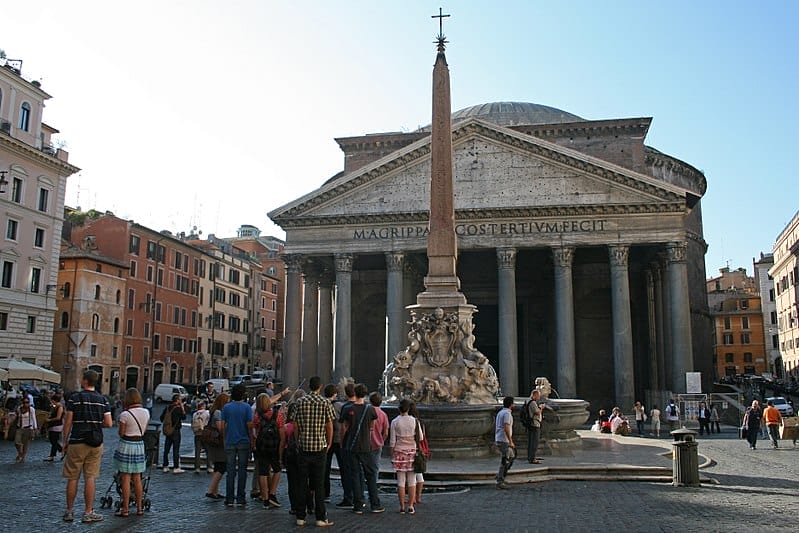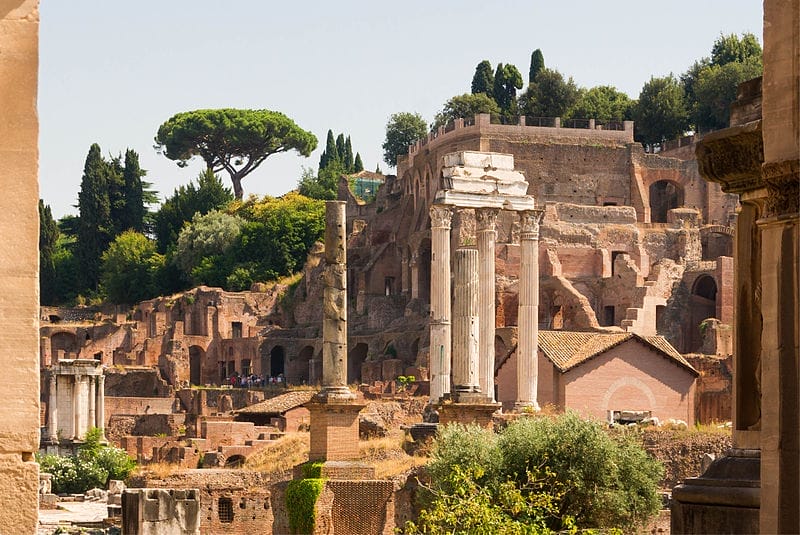Tourism in Ancient Rome was a significant aspect of the city’s economy and culture. The city attracted travelers from all over the world, and the tourism industry was a crucial source of income for Rome’s citizens. Visitors came to Rome to witness its grandeur, experience its culture, and marvel at its architectural wonders.
The ancient Romans were known for their love of entertainment, and tourism played a vital role in providing entertainment to the masses. The city was home to numerous theaters, amphitheaters, and other venues that hosted various events, including gladiatorial games, chariot races, and theatrical performances. These events were a major attraction for tourists, and they flocked to Rome to witness them firsthand.
Tourism in Ancient Rome was not just limited to entertainment. The city was also famous for its historical landmarks, such as the Colosseum, the Pantheon, and the Roman Forum. These structures were marvels of engineering and architecture, and they continue to fascinate tourists to this day. Rome’s tourism industry was a testament to the city’s grandeur and magnificence, and it played a significant role in shaping the city’s culture and economy.
Historical Overview
During the reign of Augustus (27 BC to 14 AD), Rome experienced a “golden age” of tourism. The city’s population grew rapidly, and it became a center of trade, commerce, and culture. Augustus initiated a number of public works projects, including the construction of roads, aqueducts, and public buildings, which improved the city’s infrastructure and made it more accessible to visitors. The city’s rich history and cultural heritage were also major draws, with visitors flocking to see the ruins of ancient temples, palaces, and public buildings.
Key Historical Periods
Tourism in Ancient Rome underwent several phases of development, each characterized by different historical and cultural factors. Some of the key periods include:
- The Republic (509-27 BC): During this period, Rome’s tourism industry was focused on religious pilgrimages and political events, such as elections and public assemblies.
- The Empire (27 BC-476 AD): Under the Roman Empire, tourism in Rome became more organized and commercialized, with the development of guidebooks, travel agencies, and lodging facilities.
- Late Antiquity (4th-6th centuries AD): During this period, Rome’s tourism industry declined due to political instability, economic decline, and the rise of Christianity, which led to the closure of many pagan temples and public buildings.
Despite these fluctuations, tourism remained an important part of Ancient Rome’s economy and cultural identity. Today, the city’s many ancient ruins and monuments continue to attract millions of visitors each year, making it one of the most popular tourist destinations in the world.
Travel and Accommodation
In Ancient Rome, travel was made easier by the extensive network of roads built throughout the empire. The Romans were known for their engineering prowess, and their roads were no exception. These roads were made of several layers of materials, including gravel, sand, and cement, which made them durable and able to withstand heavy traffic. The roads were also well-maintained, with regular repairs and upkeep. This made travel faster and more reliable than in other parts of the world at the time. The roads were used not only for trade and military purposes but also for travel and tourism.
Travelers in Ancient Rome had several options for accommodation. Inns were available in most cities and towns along the roads, providing basic lodging and meals for travelers. These inns were often run by families and were a vital part of the hospitality industry in Ancient Rome. The inns were simple but functional, with basic amenities such as beds, tables, and chairs. They were also affordable, making them accessible to a wide range of travelers. Some inns even provided entertainment, such as music and dancing, to make the stay more enjoyable.
In addition to inns, wealthy travelers could also stay in private homes or villas. These were often rented out by the owners and provided a more luxurious and personalized experience. However, they were also much more expensive and only accessible to a small percentage of travelers. Travel and accommodation in Ancient Rome were well-organized and accessible to a wide range of travelers. The extensive road network and the availability of inns made travel faster, safer, and more enjoyable, while private homes and villas provided a more luxurious option for those who could afford it.
Tourism and Economy
Understandably, tourism played a significant role in the economy of Ancient Rome. The city was a popular destination for travelers from all over the world. The tourism industry was a major source of income for the city, and it employed a large number of people.

Tourism brought an increase in trade and commerce in Ancient Rome. The city was a hub for merchants and traders who sold their goods to tourists. The trade and commerce industry was vast, and it included everything from food and drink to souvenirs and luxury items. One of the most significant trade industries in Ancient Rome was the production of souvenirs. Tourists would often purchase items such as pottery, jewelry, and figurines as a reminder of their visit. These items were produced by local artisans and sold in markets throughout the city.
Tourism also had a significant impact on the entertainment industry in Ancient Rome. The city was known for its gladiatorial games, chariot races, and theatrical performances. These events were not only popular among locals but also attracted tourists from all over the world. The entertainment industry was a significant source of income for the city. It employed a large number of people, including actors, musicians, and performers. The events were held in large venues such as the Colosseum and the Circus Maximus, which could accommodate thousands of spectators.
Tourism played a vital role in the economy of Ancient Rome. It brought about an increase in trade and commerce and had a significant impact on the entertainment industry. The city’s popularity as a tourist destination helped to create a vibrant and thriving economy.
Cultural Exchange
The tourism industry in Ancient Rome was not only about sightseeing but also about cultural exchange. Visitors from different parts of the world came to Rome to learn about Roman culture, art, and architecture, and in turn, they brought their own culture and traditions to Rome.
The visitors who came to Rome were influenced by the Roman way of life. They learned about Roman art, literature, philosophy, and engineering. They were amazed by the grandeur of the architectural wonders of Rome. They also learned about Roman law, which was a major influence on the legal systems of many countries.

Travels in the Medieval Period
Religious pilgrimages were also a significant part of tourism in Ancient Rome. People from different parts of the world came to Rome to visit the holy sites of Christianity, such as the catacombs, the Basilica of St. Peter, and the Vatican. The pilgrims brought with them their own religious traditions and practices, which influenced the development of Christianity in Rome.
Epilogue
In general, the cultural exchange that took place during tourism in Ancient Rome was a significant factor in shaping the world as we know it today. It helped to spread knowledge, ideas, and traditions, and it played a crucial role in the development of art, architecture, law, and religion. Also, it benefited Rome economically.
People Also Ask:
Was there tourism in ancient Rome?
Tourism is not an invention of modern times. Ancient Romans also liked to travel to health resorts in Greece, to wander the Egyptian pyramids, or to party on the Gulf of Naples. The wealthy Roman patrician Gaius Antonius lies on the terrace of his magnificent villa high above the Gulf of Naples and looks out at the sea.
What was travel like in ancient Rome?
Transportation in Ancient Rome was different from today’s world. They didn’t have cars or airplanes, but they developed an impressive transportation system with highways, horse-drawn chariots, and boats.
Where did Roman emperors holiday?
Pompeii, Stabiae, Herculaneum, and other nearby communities were the year-round vacation destinations of Roman aristocrats. The region’s pleasant climate even persuaded emperors such as Augustus and Tiberius to build imperial villas on the coast of adjacent islands, including beautiful Capri.
Did tourism exist in ancient times?
Herodotus of Halicarnassus is the first known tourist in history. He was a Greek historian and author who described his travels through Asia Minor and the Black Sea in his writings called “The Voyage of the Persian Wars.” His observations make him one of the first travel writers and early tourists. Also, he is known as the father of history.
Why is Rome famous for tourism?
With its unparalleled history, Rome is the third most visited city in Europe and the fourteenth worldwide. It attracts visitors from all over the world who are impatient to discover the city’s impressive monuments and archaeological sites; not to mention its renowned cuisine and its lively atmosphere. The Eternal city really has a lot to offer.
Hello, my name is Vladimir, and I am a part of the Roman-empire writing team.
I am a historian, and history is an integral part of my life.
To be honest, while I was in school, I didn’t like history so how did I end up studying it? Well, for that, I have to thank history-based strategy PC games. Thank you so much, Europa Universalis IV, and thank you, Medieval Total War.
Since games made me fall in love with history, I completed bachelor studies at Filozofski Fakultet Niš, a part of the University of Niš. My bachelor’s thesis was about Julis Caesar. Soon, I completed my master’s studies at the same university.
For years now, I have been working as a teacher in a local elementary school, but my passion for writing isn’t fulfilled, so I decided to pursue that ambition online. There were a few gigs, but most of them were not history-related.
Then I stumbled upon roman-empire.com, and now I am a part of something bigger. No, I am not a part of the ancient Roman Empire but of a creative writing team where I have the freedom to write about whatever I want. Yes, even about Star Wars. Stay tuned for that.
Anyway, I am better at writing about Rome than writing about me. But if you would like to contact me for any reason, you can do it at contact@roman-empire.net. Except for negative reviews, of course. 😀
Kind regards,
Vladimir
